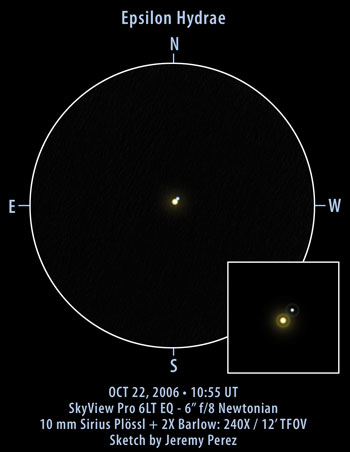 Observation Notes:
Observation Notes:
This was a great double to observe. The primary is a bright, third magnitude pale yellow star with a much fainter seventh magnitude, blue-gray companion resting right up against it. When the seeing was choppy, this secondary disappeared into the overpowering wash of yellow. I thought it looked a bit like a little bluebottle fly sitting on the edge of a fluttering sunflower.
PA appeared to be about 315°. The first diffraction rings seemed to be barely in contact, which indicated a separation of 2.5 to 3 arcseconds. According to the Washington Double Star Catalog, the primary is itself comprised of 2 stars of magnitudes 3.8 and 5.3. The period of the very close AB pair is 15.05 years, and the AB-C period is 890 years.
| Subject | Epsilon Hydrae (STF 1273) |
| Classification | Double Star |
| Position (J2000) | [RA: 08:46:46.1 / Dec: +06:25:09]* |
| Position Angle* | AB-C=195° (1825) AB-C=271° (1959) AB-C=292° (1994) |
| Separation* | AB-C=3.2" (1825) AB-C=3.1" (1959) AB-C=3.0" (1994) |
| Magnitudes* | A=3.8; B=5.3; AB=3.6; B=7.8 |
| Spectral Types* | - |
| Date/Time | OCT 22, 2006 - 3:55 AM MST (OCT 22, 2006 - 10:55 UT) |
| Observing Loc. | Cinder Hills Overlook, Sunset Crater National Monument, AZ |
| Instrument | Orion SVP 6LT Reflector (150 mm dia./1200 mm F/L) |
| Eyepieces/Mag. | 10 mm + 2X Barlow (240X) |
| Conditions | Clear, calm |
| Seeing | 5/10 |
| Transparency | NELM Mag 6.8+ |
| References | The Washington Visual Double Star Catalog, 1996.0 (Worley+, 1996), Visual Double Stars in Hipparcos (Dommanget+, 2000) via VizieR |
*Based on published data.




